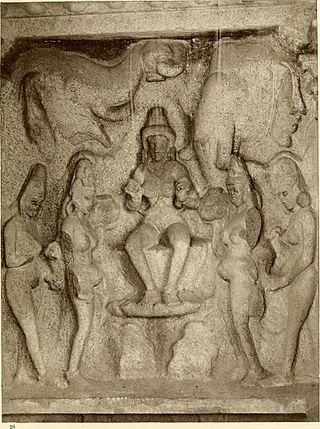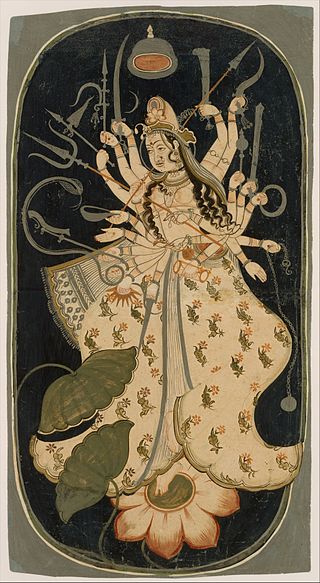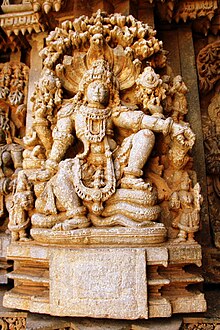
Shesha, also known by his epithets Sheshanaga and Adishesha, is a serpentine demigod (naga) and king of the serpents (Nagaraja), as well as a primordial being of creation in Hinduism. In the Puranas, Shesha is said to hold all the planets of the universe on his hoods and to constantly sing the glories of Vishnu from all his mouths. He is sometimes referred to as Ananta Shesha.

Narada, or Narada Muni, is a sage-divinity, famous in Hindu traditions as a travelling musician and storyteller, who carries news and enlightening wisdom. He is one of the mind-created children of Brahma, the creator god. He appears in a number of Hindu texts, notably the Mahabharata, telling Yudhishthira the story of Prahalada, and he also appears in the Ramayana and the Puranas. A common theme in Vaishnavism is the accompaniment of a number of deities such as Narada to offer aid to Vishnu upon his descent to earth to combat the forces of evil, or to enjoy a close view of epochal events. He is also referred to as Rishiraja, meaning the king of all sages. He was gifted with the boon of knowledge regarding the past, present, and the future.
Purusha is a complex concept whose meaning evolved in Vedic and Upanishadic times. Depending on source and historical timeline, it means the cosmic being or self, awareness, and universal principle.

Vaikuntha, also called Vishnuloka, and Tirunatu (Tirunāṭu) in Tamil, is the abode of Vishnu, the supreme deity in the Vaishnava tradition of Hinduism, and his consort, Lakshmi, the supreme goddess of the sect.

The Bhagavata Purana, also known as the Srimad Bhagavatam, Srimad Bhagavata Mahapurana or simply Bhagavata (Bhāgavata), is one of Hinduism's eighteen great Puranas (Mahapuranas). Composed in Sanskrit and traditionally attributed to Veda Vyasa, it promotes bhakti (devotion) towards Krishna, an avatar of Vishnu, integrating themes from the Advaita (monism) philosophy of Adi Shankara, the Vishishtadvaita of Ramanujacharya and the Dvaita (dualism) of Madhvacharya. It is widely available in almost all Indian languages.

Gaudiya Vaishnavism, also known as Chaitanya Vaishnavism, is a Vaishnava Hindu religious movement inspired by Chaitanya Mahaprabhu (1486–1534) in India. "Gaudiya" refers to the Gaura or Gauḍa region of Bengal, with Vaishnavism meaning "the worship of Vishnu". Specifically, it is part of Krishnaism—Krishna-centric Vaishnavite traditions.

Narayana is one of the forms and epithets of Vishnu. In this form, the deity is depicted in yogic slumber under the celestial waters, symbolising the masculine principle and associated with his role of creation. He is also known as Purushottama, and is considered the Supreme Being in Vaishnavism.

Pradyumna is the eldest son of the Hindu deities Krishna and his chief consort, Rukmini. He is considered to be one of the four vyuha avatars of Vishnu. According to the Bhagavata Purana, Pradyumna was the reincarnation of Kamadeva, the god of love. The Mahabharata states that Pradyumna was a portion of Sanat Kumara.

Aniruddha is a character in Hindu mythology, the son of Pradyumna and Rukmavati, and the grandson of Krishna and Rukmini. He is said to have been very much like his grandfather, to the extent that he is considered by some to be a Jana avatar, an avatar of Vishnu. He is a member of the chatur-vyuha, the four Vrishni heroes.

Garbhodakaśāyī Vishnu is an expansion of Mahavishnu. In Gaudīya Vaishnavism, the Sātvata-tantra describes three different forms of Vishnu as: Mahāvishnu, Garbhodakaśāyī Vishnu and Ksirodakaśāyī Vishnu (Paramātmā). Each form has a different role in the maintenance of the Universe and its inhabitants.

In Hindu cosmology, the Kshira Sagara or Ocean of Milk is the fifth from the centre of the seven oceans. It surrounds the continent known as Krauncha. According to Hindu scriptures, the devas and asuras worked together for a millennium to churn this ocean in order to acquire amrita, the elixir of immortal life. The episode is mentioned in the Samudra Manthana chapter of the Puranas, a body of ancient Hindu legends. The Kshira Sagara is described as the place where the deity Vishnu reclines over his serpent-mount Shesha, accompanied by his consort, Lakshmi.

The Devi Bhagavata Purana, also known as the Srimad Devi Bhagavatam, Srimad Bhagavatam, Bhagavata Purana or simply Devi Bhagavatam, is one of the eighteen Mahapuranas of Hinduism. Composed in Sanskrit by Veda Vyasa, the text is considered a major purana for Devi worshippers (Shaktas). It promotes bhakti (devotion) towards Mahadevi, integrating themes from the Shaktadvaitavada tradition. While this is generally regarded as a Shakta Purana, some scholars such as Dowson have also interpreted this Purana as a Shaiva Purana.
Svayam Bhagavan is a Sanskrit concept in Hinduism, referring to the absolute representation of Bhagavan as the Supreme God in a monotheistic framework. The concept is most commonly associated with a male deity, for instance in Hindu sub-movements like Krishnaism and Gaudiya Vaishnavism, in which Krishna is regarded as Svayam Bhagavan.
Para Brahman or Param Brahman in Hindu philosophy is the "Supreme Brahman" that which is beyond all descriptions and conceptualisations. It is described as the formlessness that eternally pervades everything, everywhere in the universe and whatever is beyond.

Ksirodakasayi Vishnu is a form of the Hindu god Vishnu. As the Paramatma, he is described to "enter every atom and the heart of all beings as a witness, and gives remembrance, knowledge and forgetfulness”.

The Lakshmi Tantra is one of the Pancharatra texts that is dedicated to the goddess Lakshmi and Narayana (Vishnu) in Hinduism. It forms a part of the Agamas. The Lakshmi Tantra is devoted to the worship of the goddess Lakshmi, although it also glorifies all women in general.

Mahadevi, also referred to as Adi Parashakti, Mahamaya and Durga, is the supreme goddess in Hinduism. According to the goddess-centric sect Shaktism, all Hindu gods and goddesses are considered to be manifestations of this great goddess, who is considered as the Para Brahman or the ultimate reality.
The Srimad Bhagavata is one of the main books of Hindu philosophy. The Bhagavata is a devotional account of the Supreme Being and His incarnations. The second book of the Srimad Bhagavata covers the creation of the universe according to Hindu Mythology and gives a summary of the Bhagavata. This book consists of 10 chapters. The Bhagavata is authored by Veda Vyasa and the source material for this summary is the translation presented by Swami Tapasyananda. Additional material and analysis is included.
The Srimad Bhagavata is one of the main books of Hindu philosophy. The Bhagavata is a devotional account of the Supreme Being and His incarnations. The third book of the Srimad Bhagavata covers the teachings of Rishi Maitreya to Vidura, Vishnu's Boar incarnation, the curse of Vishnu's attendants, and the teachings of Kapila Muni. This book consists of 33 chapters. The Bhagavata is authored by Veda Vyasa and the source material for this summary is the translation presented by Swami Tapasyananda. Additional material and analysis is included.

In Hindu cosmology, the Karanodaka or the Garbhodaka, also referred to as the Causal Ocean, is the origin of material creation. It is the place in the spiritual sky where Mahavishnu lies down and creates the material world. The Causal Ocean is the border between the spiritual and material worlds.


















